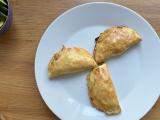Beetroot Quiche (with a Side Salad)
Table of Contents
Jump to Recipe
Jump to Carbon Footprint
This quiche is a basic recipe: the version shown here is made with beetroot, but it can easily be modified with other vegetables. The best known is probably Quiche Lorraine, which is essentially a filling of bacon, eggs, and cream. But there are no (well, very few) limits to your imagination: It can be made with spinach, tomatoes, courgettes, asparagus or whatever else you have in the house.
Quiche is the perfect meal to prepare and reheat: it’s delicious fresh from the oven, but you can also eat it cold afterwards or heat it up again.
A small salad is the perfect accompaniment to quiche: the slight acidity of the dressing and the crunch of the fresh lettuce leaves contrast well with the soft quiche and make it a little easier to digest.
If you’re in a hurry, you can use ready-made dough from the fridge - but I haven’t found one I really like yet. The dough is very quick and easy to make: So if you spend the extra five minutes, you’ll be rewarded with what I think is a much better result.

Recipe #
Beetroot quiche
60 minutes
6 portions
Ingredients #
For the dough:
- 250 g flour
- 2 g salt
- 125 g butter
- 1 egg
- 20 ml milk
For the filling and glaze:
- 1 onion
- 1 clove garlic
- 20 g oil
- 4 eggs
- 250 ml milk
- 500 g beetroot (cooked and peeled)
- 4 g salt
- 1 pinch of nutmeg
- 50 g grated cheese
For the side salad - for two portions:
- about 120 g lettuce
- 4 tablespoons oil
- 2 tablespoons vinegar
- 1-2 teaspoons mustard
- 1 teaspoon honey, agave syrup or a similar sweetener
- 1 pinch of salt
- 1 pinch of pepper
Directions #
- Prepare the dough: Mix the flour and salt together in a bowl. Cut the cold butter into small pieces and add. Knead the butter into the flour with a spoon and/or your hands (don’t use a food processor - it won’t work). Add the egg and milk and knead again. Shape into a ball and chill until step six.
- For the filling, peel and chop the onion and garlic. Fry in a pan with a little oil until the onions are soft.
- Dice the beetroot.
- For the glaze, whisk the eggs and milk together in a bowl. Season with salt and pepper, then add the beetroot, fried onion and garlic and mix. Add the grated cheese.
- Preheat the oven to 200°C (fan oven).
- Spread a little flour on the work surface and put the dough on it. Using a rolling pin, roll out the dough until it is slightly larger than the tin in which the quiche will be baked. Line the tin with greaseproof paper, spread the pastry into the tin and pull up the sides of the tin to form a rim. Prick the base of the pastry with a fork.
- Blind bake in the oven for about 5 minutes - cover the dough with baking paper and sprinkle the dried lentils/peas/chickpeas on top to prevent the dough from bubbling.
- When blind baked, remove the baking tin from the oven and remove the pulses used for blind baking. (The pulses don’t have to be thrown away, you can always reuse them for blind baking if you store them in an empty jam jar in the meantime, for example) Then add the actual filling and icing to the dough in the pan.
- Bake in the middle of the oven for 30-40 minutes.
- While the quiche is baking, you can relax and prepare the side salad: For the dressing, mix the oil, vinegar, mustard, honey, salt and pepper in a bowl. Wash the lettuce and add to the dressing just before serving.
Carbon Footprint #
One quiche makes eight servings. To compare the carbon footprint with other recipes, it has been converted to two portions.
In total, two portions of beetroot quiche with side salad have an estimated carbon footprint of 1182 g
This ranks it number 21 out of 57 recipes published on the blog so far in terms of estimated carbon footprint.
The estimated emissions are therefore still slightly better than the average of the recipes.Among the ingredients, butter stands out: We use very little butter in the dough, and it accounts for only 6% of the weight of the ingredients, but almost 30% of the CO2 emissions of the dish. This is, of course, due to the carbon footprint of rearing animals to produce milk and the fact that a relatively large amount of milk is needed to make butter: Around 20-25 litres of milk are needed to make 1kg of butter. Of course, it is possible to replace butter with other ingredients - for example, many ready-made doughs in the supermarket use palm oil, which has a better carbon footprint than butter, but is sometimes produced under ethically questionable conditions.
Of the ingredients in the quiche, beetroot and lettuce are roughly the opposite of butter: together they make up about 40% of the total weight of the ingredients, but only about 6% of the carbon footprint.
| ingredient | carbon footprint per kg | carbon footprint (in g) for 2 servings | % of ingredients | % of CO2 emissions |
|---|---|---|---|---|
| Flour | 0.9 | 74 | 12% | 6% |
| Salt | 1.1 | 1 | 0% | 0% |
| Butter | 9.0 | 375 | 6% | 32% |
| Egg | 3.0 | 50 | 2% | 4% |
| Milk | 1.4 | 9 | 1% | 1% |
| Onion | 0.2 | 5 | 4% | 0% |
| Garlic | 0.5 | 0 | 0% | 0% |
| Oil | 3.2 | 21 | 1% | 2% |
| Egg | 3.0 | 200 | 10% | 10% |
| Milk | 1.4 | 117 | 12% | 12% |
| Beetroot | 0.2 | 33 | 24% | 3% |
| Salt | 1.1 | 2 | 0% | 0% |
| Nutmeg | 1.1 | 0 | 0% | 0% |
| Grated cheese | 5.7 | 95 | 2% | 8% |
| Salad | 0.3 | 36 | 17% | 3% |
| Oil | 3.2 | 64 | 3% | 5% |
| Vinegar | 1.4 | 14 | 1% | 1% |
| Mustard | 1.4 | 14 | 1% | 1% |
| Honey | 2.0 | 20 | 1% | 2% |
| Salt | 1.1 | 1 | 0% | 0% |
| Pepper | 1.1 | 0 | 0% | 0% |
| Sauté the onion and garlic (5 min) | <1g | 0% | ||
| Bake quiche (35 min) | 50 | 4% |


